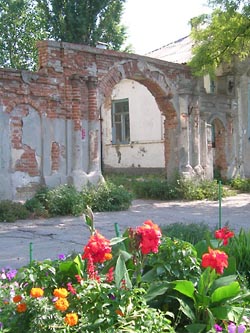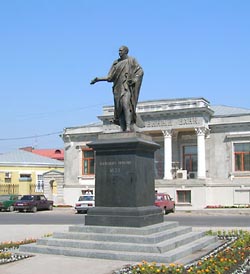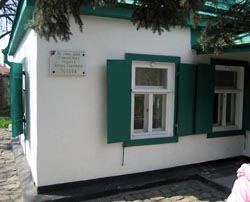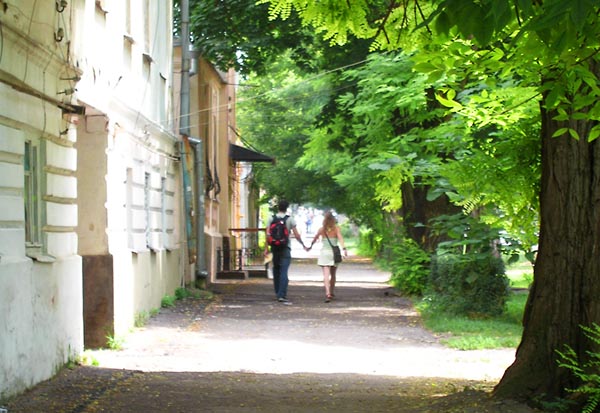| Tell a friend | Print version |
|---|
Taganrog Started By the Sea
RUSSIAN TSAR PETER THE GREAT MADE HIS FIRST ATTEMPT TO “OPEN A WINDOW TO EUROPE” ON THE SHORES OF THE AZOV SEA. THE CAPITAL THAT NEVER HAPPENED TURNED OUT RICH WITH TALENT.

The Sea of Azov is famous for its capricious character, strong winds and sudden squalls. That’s probably why Taganrog is popular with yachtsmen and windsurfing lovers. Photo by author
The city starts at the sea, at the cape where once stood the tent of its founder’s, Peter I, and extends into the steppe. Into the endless, ever-blooming Southern steppe, so lively described by the native of the city, Anton Chekhov: “The brownish-green, sun-baked hills, appearing lilac from afar with their soft muted tints, the plain and the hazy distance, and that overarching sky – so breathtakingly deep and transparent in the steppes where there are no forests or high mountains… Only at sea or on the steppe at night, when the moon is shining, can you judge the sky’s unfathomable depth and boundlessness. It is awesome, beautiful and inviting, looking down languidly and beckoning you – and your head grows dizzy from its blandishments.” But Chekhov did not describe the sea.
“As I was reading these words,” remembers Paustovsky, “something felt tantalizingly familiar. I was searching for any kind of a name by which to recognize the city. Somewhere in the depths of my consciousness I already knew the city that was being described… “It’s surprising that in the books of one of our wonderful writers, native of this city, none of the mentioned above is reflected – not the sea, nor the ports, nor the acacias, nor the black sails.” These words held the answer. But of course, all of this was written about Taganrog, the birthplace of Chekhov.”
The sea of Taganrog was described by Paustovsky. “In 1916 I settled in Taganrog, in a large, empty and cool hotel Kumbaruli. It was built in those legendary times when Taganrog was the wealthiest city on the Sea of Azov and the capital of the Greek and Italian merchants. In those times, Taganrog housed the brilliant Italian opera, and was the home of Garibaldi and the infatuated with Greece poet Sherbina. This was the place where the bald-headed dandy Alexander the First lived and died, surrounded by his refined entourage.”

The old city ruins. Some sidewalks are still covered with the ancient colored tile. Photo by author
What remains of this city? The Taganrog National Museum-Preserve of Literature, History, and Architecture guards its memory.
The city has approximately 300 thousand inhabitants but it looks even smaller than that; one can walk the streets here by foot; they are appropriate in size for human beings, with one- or two-story cottages, green, filled with memory of the 19th century. Even the announcement posts, taken down in other cities, still remain. This place is quiet, cozy, filled with light - and forgotten. Apricots, lilac, and white acacias blossom in the spring, and the air is filled with the aroma of the gardens. In the summer, the apricots and mulberries drop right underneath your feet, and grapes and walnuts are plentiful. Nights are warm and starry; one can sleep out in the open, listen to the sea and watch the flight of the bats. Birds sing at dawn. A pink patch develops above the water and the sun is born from the mist of the sea.
The city seems to be eternal. As if in evidence, the low tide leaves pieces of ancient Greek crockery on the sand.
The abundance of fish and chernozem and the proximity of the great rivers, Don and Volga, became the necessary prerequisites for profitable trade. Already in the 7th century b.c. this area was inhabited by the Greeks – this was the first Greek colony in the Northern Black Sea region. Farther away, in the 3rd century b.c., the city of Tanais was founded – the Northern-most of all the Greek colonies. 12th century b.c. gave rise to the predecessor of the modern-day Taganrog – the Italian Porto Pizano – a colony of the once-great sea republic of Piza. And only later, following the Amazons (mentioned by Herodotus), the Greeks, the Cimmerians, the Scythians, the Sarmatians, the Italians, and the members of the Golden Horde, Peter the Great had finally arrived.
Military Port
Taganrog is the first Russian naval fortress; the predecessor of St. Petersburg, the embodiment of the century’s long yearning of the Northern Empire for the Southern seas, it was founded over long battles with the Turks. Twice it was demolished to the ground. Twice it was reborn.The tsar arrived at the high cape and ordered the harbor and the city into existence. Everything was dictated by the state-of-the-art technology of the time. The General Manshtein wrote, “Everyone who has seen the harbor admits it to be the best harbor in Europe.”

Alexander I died in 1825 in Taganrog and the Taganrog citizens decided to immortalize the memory of the Emperor’s stay on their land. The monument was formally opened in 1831. In 1920 it was blown up and restored in 1999. Photo by author
When the Russo-Turkish War renewed, the harbor already hosted a strong fleet. But far away, on the Prut River, the Russians suffered a defeat. “It’s hard to believe I am writing this by my own hand,” said Peter I, “but the Turks need to be pleased… Taganrog should suffer extensive ruin, but taking care not to damage the foundations, for God may will otherwise.”
History took the reverse course. The future of Russia was now in the North, where St. Petersburg was being built, and the Southern city, conceived to be the capital of the growing Empire, lay in ruin.
Peter died. St. Petersburg blossomed. But God “willed otherwise” and the Empire again headed South, now under the direction of Catherine.
Franz Lefort, Fyodor Apraksin, Dmitry Senyavin, Cornelis Cruys, Vitus Bering, Fyodor Ushakov – all served in Taganrog. From here Russia started on its way to Bosphorus and Dardanella, conquered Crimea, built Sevastopol, and made this new port its main naval base in the South.
On the spot where once stood the tent of Peter I, on the high cape, a church to Nikola Morskoy (Temple of St. Nicholas of the Sea) was built. The captured Turkish weapons were used to cast church bells. The temple was erected by sailors, and the church-goers were sailors and fishermen, whose descendants, also fishermen, still live in the picturesque alleys of Bogudoniya. The Church overlooked the sea, the arena of the brutal battles for the Russian future in the Southern seas.
Chersonese, Sevastopol. A church bell sits by the precipice. During the Crimean War it was taken to Paris, to the Notre Dame, and only in 1913 returned to Russia to be placed in the Chersonese monastery. With the arrival of the Soviet regime, the church bells were melted down – all except this one. And until the 1960s, this bronze veteran served as a sound beacon. They call it The Fog Bell (Tumanny Kolokol).
It is older than Sevastopol itself. A partially intact inscription is still legible: “This bell is cast for Saint Nicholas the Wonderworker in Taganrog… from the captured Turkish artillery… weighing… pood pound on… August, 1778.”
When Crimea joined Russia, Taganrog ended up in a military rear; the Church was taken away from the military ministry and its heroic bells were transferred to the new naval base in the South. But the walls of the Nikola Morskoy Temple still remember the Crimean War; the enemy’s cannonballs will stay embedded in them for centuries to come.

House of the Chekhov family, where in 1860 the great Russian writer was born - precisely what is written on the memorial plaque on the wall. “Checkhov’s House” is now a museum. Photo by (Creative Commons license): Yurri Akopov
In the small side wing of the house you can find a folk painting: military steam ships of the allies fire on the city during a raid; a bayonet fight with the Anglo-French landing troops takes place by the fortress walls, on the shore and on the Kamennaya Lestnitsa (Stone Stairs).
The city dwellers were fighting blazing fires, but the mass was still held at Nikolsky Temple (St. Nicholas Temple). The bombardments continued for two weeks, the enemy squadrons roamed the sea, but the city remained standing. Alexander II sent a letter of gratitude to the citizens of Taganrog.
Commercial Port
When the Nikolsky Temple (St. Nicholas Temple) was taken away from the military ministry, a local Taganrog government was formed; the city was being transformed from a fortress into a commercial port, subordinate directly to the capital. A large number of foreigners, merchants, and ship owners settled in Taganrog. In those times, the port had twice the freight turnover of the port of Odessa.“Taganrog is a Greek kingdom,” wrote Sleptsov already in 1887. “It is a bit reminiscent of Kiev, except here live the Greeks.” “Greek coffeehouses were full of skippers, commission agents, brokers. The town garden cat’s name was Themistocles.” Anton Chekhov received his elementary education in a school belonging to a Greek church. Chekhov’s father believed that studying in a Greek school would help his children in their future commercial carrier.
Requiem service for the Emperor Alexander I was performed at the Greek monastery (founded by Ioannis Varvakis, a Greek pirate, a Russian officer and a hero of the war for independence of Greece).
In the port, in one of the osterias, young captain Garibaldi met revolutioner Cuneo and swore to dedicate his life to the liberation of his homeland. The only existing monument to Garibaldi on the territory of the former USSR is the one in Taganrog.
The stone stairs, predecessors of the Potemkin Stairs of Odessa, were built in the 1820s, financed by a Greek merchant Depaldo. The old steps were made of yellow Sarmatian stone. Recently, the old, eroded steps, worn out by the millions of feet from history, were replaced by smooth slabs of granite.
At the same time, an antique sun dial was installed on the observation deck of the stairs. The shadow, gliding over the antique writings on the ancient slab, shows the true astronomical time of Taganrog.
City of the Arts
On the right of the sun dial stands a house with a toothed turret, crowned by a weather vane in the form of a sailboat. This house belongs to Captain Ippolit Ilyich Tchaikovsky; Pyotr Ilyich, the composer, came here to visit his brother.Small streets (in the 19th century considered wide), decorated with two rows of trees, radiate out from the former fortress and from the port – Taganrog is the first Russian city built according to a design. Having survived two world wars, the city (the location of Denikin’s headquarters during the Civil War) nevertheless preserved its original architectural look almost intact.

Here’s how Taganrog was described by Mikhail Chekhov: “Taganrog is a new city; the streets are straight and the buildings neat, and trees are planted everywhere giving its streets and alleys the look of parkway boulevards.” Photo by author
Heavy carved doors, copper handles, mechanical doorbells, ornamented tiles, mascarons, wrought fences, azure balconies and wells still remain. Hurry – all this may disappear – the wooden carved window frames are already being replaced by modern dual-pane windows, and where before grew trees too thick to embrace, now lie modern walkway tiles. But not everything is taken down, reconstructed or thrown away yet, and the city of old still exists – not a modern replica, but as authentic as Pompeii.
Old streets are filled with history. Here’s a dilapidated building housing military quarters of the Peter’s fortress. And here’s where Pushkin saw his Lukomorie – in the bend of the bay and in the enormous mulberry tree. It’s unclear whether the poet was not familiar with botany, or whether it was important for him that the tree turns out to be an oak. Several years ago the mulberry tree burned down, after being hit by lightening.
The house where Pushkin lived and where Alexander I himself lived and died is still standing on a quiet and green Grecheskaya Street (Greek Street). It is now a health resort for children.
A monument to Alexander I was erected in 1831, across from the Greek Monastery; the Monastery building and the monument were both lost, but now the monument’s exact replica, copied from a surviving gypsum model, stands in its place. This is the only existing monument to Alexander in Russia. Its sculptor, Martos, once student of the Taganrog gymnasium, is also the author of the monuments to Duc de Richelieu in Odessa and Minin and Pozharsky on the Red Square.

A strange fact about the Russian 500 ruble note that is now in use – it depicts the statue of Peter I by Antakolsky erected in Taganrog, but the inscription maintains its location to be Arkhangelsk
And here’s the gymnasium itself, the oldest in the South, attended by Chekhov. This is also where Dzerzhinsky’s father taught. Today it’s a Literary Museum. Here’s the monument to Peter I, from the 500 ruble note. Antokolsky made it in Paris, and it was transported here by sea from Marseille. Here’s the theater, a miniaturized La Scala with wonderful antique-quality acoustics, where young Chekhov watched performances of Sheakspeare and where Italian Opera was performed. Here’s the park, also oldest in the South, the place of Chekhov’s promenades and Ranevskaya’s romantic rendezvous.
And here’s Ranevskaya’s house. The palace of Senator Alferaki, friend of Bryullov, built by Shtakenshneider – this is where Ranevskaya first heard the music performed by Skryabin. It now houses the Museum of Regional Studies. Here’s the gymnasium where she studied. It’s still an active gymnasium. It was also attended by Sophia Parnok, the poetess celebrated by Tsvetaeva in her poems. Parnok’s father owned a drug store, and the old house with old lanterns is still a drug store. And here’s the house where Parnok lived. It’s still a residential building.
Here’s the house of the children’s writer Vasilenko. The house of Durov is in the alley to the right. Both host museums. Here’s the school attended by Elena Obraztsova, and this one here – by Sergei Bondarchuk. Petrovskaya Street still remembers the Cimmerian Maksimilian Voloshin, the “Greek from Taganrog”, the poet Nikolay Sherbina, and the poet and playwright Nestor Kukolnik. And the two-story building with a balcony entwined with grape vines is where Kuindzhi began his career.
The entire Chekhov Street is a memorial to the writer and to his characters. The prototype of Ionych, the wealthy doctor, lived here, and the gymnasium teacher, prototype of The Man in a Shell – in that house there. The street ends in a square with the monument to the writer, surrounded by the “colonnade” of Campiani - this is the Aleksandrovskiye Torgovye Ryady (Alexander’s Bazaar), the setting for Chameleon.
The Chekhov’s family shop. The second floor interiors and the small balance weights in the trading area on the first – everything is carefully collected, reconstructed. “Tea, Sugar, Coffee and Other Colonial Produce” - reads the sign. The Chekhov’s Library – Chekhov himself was its reader; it contains volumes selected by the already writer Chekhov himself, and the building is built by his friend, academician Fyodor Schechtel. The Art Museum – part of its collection was presented to the city by Chekhov. The old cemetery with its marble monuments to merchants and to Italian opera divas is described by Chekhov in Ionych.
And the house with the turret, built by Schechtel, with lions by Vrubel and panels by Roerich, is now a Museum of Taganrog Municipal Building and Life.
Source: , author: Inna Mukhlaeva



